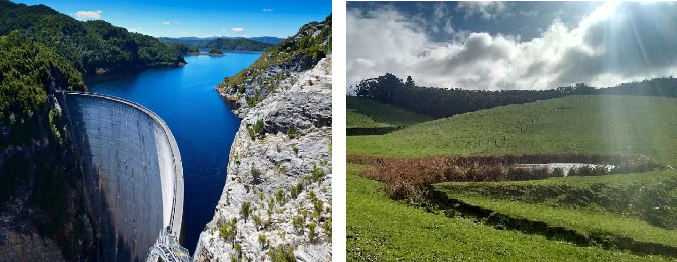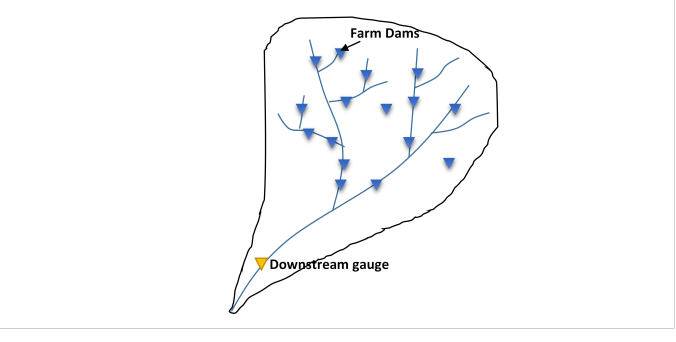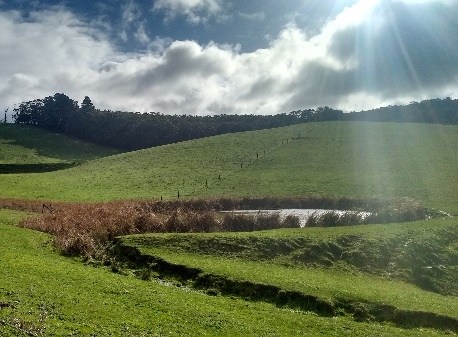A farm dam in this article refers to an ‘on-stream dam’. They are typically a barrier built on a surface water flow path for the purpose of holding back and storing the runoff or flow along that flow path, which otherwise would flow downstream.
Farm dams are commonly located on the hillside of head-water catchments and vary in size (from a few kilo-litres to hundreds of mega-litres) and location within a catchment.
2 – There are lots of farm dams!
In Australia there are over 2 million farm dams storing 8 million ML. This volume is equal to the combined storage capacity of Australian capital city reservoirs.
3 – The cumulative impacts of farm dams can be significant
Consider a large engineered dam, such as the Gordon River Dam (illustrated below). In the past, large dams have caused significant controversy over their potential environmental impacts.
These impacts may include:
- issues with water quality
- weed infestation
- loss of habitat
- sediment build-up in channels
- disappearing aquatic species
- and so on.
Not surprisingly, regulations and water policies exist around the construction and operation of large dams to mitigate impacts.
In contrast, a small dam has only a minor impact. The cumulative impact of farm dams constructed across the landscape is not unnoticed since, by design, they interrupt and alter the natural flow regime. However, by their mere presence (not-withstanding the water lost through evaporation and the water taken out for use) they do capture all the runoff / low flows generated from their upstream catchment area, until they are full and spilling. This has direct impacts downstream, in that the dry seasons are extended for a further period until the dams are spilling, and this has direct consequences on the downstream water needs, including the needs of water dependent ecosystems.
Historically, farm dams were largely unregulated. However, since the extensive development of farm dams across South Australia (and other states in Australia) during the 80s and 90s, policy and legislative tools have been developed to manage their growth in a sustainable manner.

Figure 1: Photo of (a) Gordon River Dam, Tasmania (source) and (b) a farm dam in the Mount Lofty Ranges.
4 – It is possible to balance agricultural and environmental needs
With careful planning and better modelling it is possible to balance consumptive needs and environmental flow requirements. A key way to do this is to focus on low flows.
Low flows are a small portion of the total flow volume each year, but are highly significant in terms of the ecological health of watercourses. For example, in the Mount Lofty Ranges of South Australia, many creeks are seasonal: The highest flows are in winter, and are isolated pools in dry creek-beds in summer. Low flows that occur, in particular during the late autumn / early winter period, the late winter / early spring period and summer, are critical for maintaining the health of habitats for native aquatic species.
With growing recognition of the importance of low-flows, there are increasing efforts to return environmental flows to the system with minimal impacts on the functioning of the farm dams. This objective requires better understanding of hydrological processes at the farm dam scale.
5 – The hydrology of farm dams is different from larger engineered dams
There are many significant differences between large dams (generally constructed as ‘water supply’ reservoirs) and farm dams. Some of these differences include:
- Instrumentation: Large dams are highly instrumented while farm dams are not
- Budgets: Large dams have large budgets while farm dams are constructed on private properties
- Regulation: Large dams are highly regulated while farm dam regulation is more recent and is not exhaustive
- Hydrology: Hill-slope hydrology is dependent on local infiltration while catchment hydrology aggregates many more processes
- Scale: Large dams have larger catchment areas while farm dams have only a small contributing area.
Farm dams are typically located upstream in head-water catchments that are often ephemeral in nature (Figure 2). They are small in size and storage and have small contributing areas, in comparison to the larger reservoirs. They are located on hill-slopes, with the average catchment slope generally steeper.
The scale of hydrological processes involving farm dams is small compared to large dams located downstream. Downstream flows tend to be more consistent, where flow varies more smoothly. Upstream flows tend to be short-lasting and more variable (Figure 2).
This contrast has implications for modelling options.

Figure 2: Conceptual illustration of the hydrological behaviour of stream flow.
6 – There are challenges of modelling farm dam behaviour
Balancing agricultural and environmental water requirements can be difficult. Managing competing water allocations requires appropriate and fit-for-purpose hydrological modelling tools. The high variability of the configuration (size, design, location within a catchment, to name a few) of the individual farm dams, combined with the high hydro-climatic variability within the catchments and sub-catchments they are located in, poses an enormous challenge in modelling the behaviour of individual farm dams at a property scale.
Fit-for-purpose models (Conceptual Vs Physical Vs Hybrid)
A challenge for farm dam modelling is the distributed nature of farm dams and the distributed nature of upstream catchment conditions. Historically, conceptual hydrological models, with lumped catchment parameters and distributed farm dam and rainfall parameters, were built and calibrated to records from a downstream streamflow gauge at catchment or sub-catchment scale (Figure 3). This effectively aggregates the runoff generation parameters across the catchment or sub-catchment into one set of model parameters. Recent advances in modelling have seen un-lumping or explicit spatial representation of some of the catchment parameters (like land use and soils) that influence runoff generation processes that have led to better spatial representation of catchment behaviour in the models. However, it is acknowledged that ‘physical’ models, with targeted data collection to represent a hydrological process (or processes) that is being studied, provide a better understanding of that particular process (or processes) at the scale at which the data is collected. With this in mind, this project aims at understanding the ‘sub-surface flows paths’ at a finer scales, which are critical in understanding and representing the interaction between surface water and groundwater. Such interactions are important when trying to understand the proportions of water bypassing a farm dam via subsurface flow pathways. Fully coupled surface-subsurface physical based modelling is one way to address this.

Figure 3: A conceptual illustration of the distributed nature of farm dams in a catchment
7 – There are opportunities for better data collection, modelling and calibration
While fine scale catchment modelling presents some significant challenges, I intend to demonstrate a way forward through my PhD studies.
My research will investigate some of the opportunities they present, including:
- Improved data collection
The instrumentation of ephemeral streams using low cost temperature sensors allows for the collection of stream flow data in head water catchments, that is rarely available. This strategy gives us opportunities to address data deficiencies at the local scale. It also makes high resolution data collection feasible.
- Distributed modelling
There is an opportunity to understand the finer scale processes of farm dams with detailed physical modelling. Fully coupled surface to sub-surface models allow the investigation of alternative sub-surface flow pathways. This can be applied to an investigation of farm dams’ impacts on flows in the study area and in other hydrologically similar areas.
- Improved calibration
Data collected in the study will be used to leverage and complement existing data (e.g. radar, rain-gauge, bore hole and permanent in-stream measurements). The additional information will allow for high resolution model calibration. The goal is to better replicate the sub-surface flow component of the hydrological cycle. This allows for not only an improved scientific understanding of the hydrology of farm dams but also allows for improved calibration methodologies.
- Resolving issues of scale.
The use of higher resolutions than is used in existing models offers the possibility of processes (e.g. soil infiltration dynamics) being represented at finer resolutions. This would make them more appropriate at the farm dam scale for the study area and for other hydrologically similar areas.
Interested in this research?
To hear more about this research please contact me by email at alicja.makarewicz@adelaide.edu.au.
Acknowledgements
I would like to thank the Department of Environment, Water and Natural Resources (DEWNR) for their contributions to this research and article. In particular I would like to acknowledge Kumar Savadamuthu, Principal Hydrologist, for his feedback and guidance.
Original article posted on INTELLIGENT WATER DECISIONS RESEARCH GROUP, 5 October 2016 (link)




